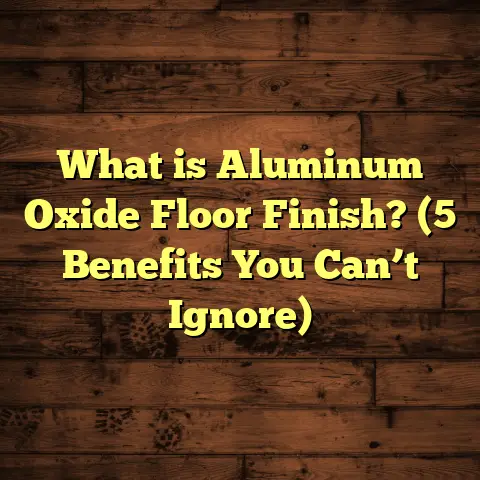What is Ucrete Flooring? (5 Benefits for Industrial Spaces)
I want to start by sharing a tip I picked up early in my flooring career that helped me understand the real value of industrial flooring solutions like Ucrete. When you’re selecting flooring for a heavy-duty environment, don’t just focus on how it looks or the initial cost. Instead, think about longevity, resistance to harsh chemicals, and how easy it is to maintain over years of use. This mindset saved one of my clients tens of thousands of dollars in repairs and downtime — and it’s advice I pass on to everyone now.
If you’ve ever had to deal with floors in an industrial setting, you know just how tough the conditions can be. Heavy equipment rolls over them, chemicals spill on them, and they get scrubbed clean constantly. Ordinary flooring materials simply don’t cut it. That’s why understanding materials like Ucrete is so important.
What is Ucrete Flooring?
Let’s break down exactly what Ucrete flooring is.
Ucrete is a type of polyurethane concrete flooring system designed specifically for environments where floors face extreme wear and tear. It’s different from your everyday concrete or epoxy floors because it combines concrete’s hardness with polyurethane’s chemical and mechanical resilience.
Technically speaking, it’s a resin-rich, polyurethane-based mortar that is poured similarly to concrete. Unlike epoxy coatings that form a surface layer on concrete, Ucrete is a thick, monolithic floor system with a chemical-resistant binder mixed with graded aggregates. This composition gives it extraordinary strength and durability.
Origins and Industry Use
Ucrete was first developed in the 1970s by a company called Flowcrete, initially for the food processing industry. The food sector demands floors that can handle:
- Frequent washdowns using aggressive cleaning chemicals
- Thermal shocks caused by hot water or steam
- Resistance to acids and fats
Because of these extreme conditions, traditional flooring materials often failed quickly. Ucrete was designed to survive these challenges.
Since then, its use has expanded beyond food processing to pharmaceuticals, chemical plants, breweries, warehouses, automotive plants, and anywhere else floors are put through harsh treatment.
How Does Ucrete Work?
The magic of Ucrete lies in its chemistry and physical properties:
- Polyurethane Binder: This provides excellent chemical resistance, flexibility, and adhesion.
- Graded Aggregates: These give mechanical strength and texture.
- Monolithic System: The entire thickness of the floor is resistant — not just the surface.
This means if the surface wears or gets lightly damaged, the underlying floor still performs well unlike epoxy coatings that may chip or peel exposing vulnerable concrete underneath.
Comparison with Other Floor Types
To give you perspective, here’s how Ucrete stacks up against common industrial flooring options:
| Flooring Type | Chemical Resistance | Mechanical Durability | Thermal Shock Resistance | Maintenance Ease | Initial Cost |
|---|---|---|---|---|---|
| Epoxy Coatings | Moderate | Moderate | Low | Moderate | Low |
| Vinyl Flooring | Low | Low | Low | Easy | Low |
| Traditional Concrete | Low | High (but brittle) | Low | Difficult | Low |
| Ucrete | Very High | Very High | Very High | Easy | High |
Successes and Challenges I’ve Seen with Ucrete Floors
Every time I recommend or install Ucrete floors, I reflect on both the wins and the hurdles I’ve faced.
Successes
One of my proudest moments involved a food processing plant in the Midwest. They had issues with their old epoxy floors cracking and peeling because of constant exposure to harsh acids and washdowns. Switching to Ucrete transformed their operation — they reported zero floor failures in over 10 years.
Here’s what made a difference:
- Durability: The floors didn’t chip under forklift traffic.
- Chemical Resistance: Spills didn’t leave stains or damage.
- Ease of Cleaning: The smooth but textured surface made washdowns faster.
Another success story was a brewery that dealt with thermal shocks from hot washing cycles followed by cold fermentation temperatures. Their old floors cracked repeatedly. After installing Ucrete, those issues disappeared completely.
Challenges
I won’t sugarcoat it — Ucrete flooring isn’t without challenges:
- Installation Expertise: The mix ratio and application process require skilled installers. I once saw an inexperienced crew mix the product improperly, leading to an uneven texture and weak spots.
- Upfront Cost: It costs more initially than epoxy or vinyl options — often double or more — which makes some clients hesitate.
- Curing Time: While faster than traditional concrete, you still need to allow proper curing time (usually 24-72 hours depending on conditions) before heavy use. Rushing this can cause issues like surface cracking or poor adhesion.
- Repairs: If damage occurs, repairs can be more complex than patching epoxy because of the mortar-like consistency.
Five Benefits of Ucrete Flooring for Industrial Spaces
Now let me walk you through five reasons why I often recommend Ucrete for industrial spaces — benefits that really stand out based on my experience and data.
1. Outstanding Chemical Resistance
Chemical resistance is probably the biggest reason industrial clients choose Ucrete.
In industries like pharmaceuticals, food processing, and chemical manufacturing, floors get exposed daily to harsh substances:
- Acids (sulfuric acid, hydrochloric acid)
- Alkalis (sodium hydroxide)
- Solvents (alcohols, ketones)
- Oils and fats
Ucrete’s polyurethane binder resists degradation from these substances where epoxy coatings or concrete would quickly fail.
Data from lab testing shows:
- Ucrete remains intact after exposure to over 50 different chemicals.
- Epoxy coatings often show signs of swelling or blistering within weeks when exposed to similar chemicals.
- Concrete can absorb chemicals leading to long-term damage.
Real-world example: A pharmaceutical company I worked with had spills of aggressive solvents like isopropanol daily. Their previous epoxy floors started blistering within weeks. After switching to Ucrete, they reported zero chemical-related floor damage over 7 years.
2. Exceptional Durability Under Mechanical Stress
Heavy foot traffic, forklifts, pallet jacks — these all put enormous pressure on industrial floors.
Ucrete’s dense aggregate structure handles this pressure much better than epoxy coatings or vinyl. It distributes loads evenly without cracking or chipping.
I worked on a logistics warehouse project where forklifts worked 12 hours a day on floors that typically needed repairs every 2 years. After installing Ucrete:
- Repairs dropped by 70% over five years
- Safety incidents related to floor damage (slips/trips) decreased
- Floors maintained their appearance despite heavy abrasion
This durability reduces both maintenance time and expenses significantly.
3. Resistance to Thermal Shock and Moisture
Thermal shock happens when floors undergo rapid temperature changes — common in food processing plants that use hot water washdowns followed by cold storage.
Traditional concrete floors crack under these conditions because they expand and contract unevenly.
Ucrete’s polyurethane binder allows some flexibility while maintaining strength. Plus, its waterproof nature prevents moisture penetration which would otherwise weaken floors over time.
I remember a meat processing plant where steam cleaning caused regular floor failures until they switched to Ucrete. Their downtime for repairs dropped dramatically afterward.
4. Easy to Clean and Maintain
Cleanliness is critical in many industrial environments — especially food and pharma. Floors need to be hygienic but also easy on cleaning crews.
Ucrete floors have a smooth yet non-slip finish that prevents dirt from embedding deeply. This makes cleaning faster, reduces chemical usage for cleaning agents, and improves workplace safety by minimizing slip hazards.
A facility manager once told me their cleaning crew cut washdown time by nearly 40% after switching to Ucrete because contaminants came off more easily compared to rougher epoxy floors.
This also helps maintain regulatory compliance with health standards since there are fewer cracks or porous spots where bacteria could grow.
5. Longevity That Saves Money Over Time
Let’s talk money — an important factor for any project manager.
While Ucrete typically costs more upfront (about $15-$30 per square foot compared to $7-$12 for epoxy), its lifespan often exceeds 15 years with minimal maintenance required.
When you factor in:
- Reduced downtime for repairs
- Lower maintenance costs
- Fewer replacements needed
- Improved safety (fewer accidents)
The total cost of ownership becomes very favorable.
Financial insight: One client calculated that switching from epoxy to Ucrete reduced their flooring-related expenses by 30% over ten years once all factors were considered.
Diving Deeper: Technical Aspects of Ucrete Flooring
To better understand why Ucrete performs so well, let me explain some technical aspects that set it apart:
Polyurethane Chemistry
The polyurethane binder is what makes Ucrete unique compared to other concrete-based floors.
It creates strong chemical bonds within the material that resist breakdown when exposed to acids or solvents. It also provides elasticity that absorbs impacts without cracking.
These properties come from advanced polymer science developed specifically for industrial applications rather than decorative coatings.
Aggregate Size and Grading
The aggregates used in Ucrete are carefully graded sizes of quartz or other hard minerals. This grading:
- Contributes to mechanical strength
- Provides better surface texture for slip resistance
- Helps distribute loads evenly across the floor
Different grades of Ucrete have varying aggregate sizes tailored for specific environments (e.g., heavy abrasion vs chemical exposure).
Thickness and Installation Layers
Typical Ucrete flooring thickness ranges from 6mm (about 1/4 inch) up to 12mm or more depending on application needs.
Because the entire thickness is chemically resistant and mechanically strong (not just a surface coating), it performs much better under stress.
Installation generally involves:
- Preparing substrate (cleaning & priming)
- Mixing resin and aggregate components on-site
- Pouring and leveling
- Allowing proper curing before use
Installation Realities: What I’ve Learned
Installation quality makes or breaks any flooring project — especially with specialized products like Ucrete.
I’ve seen both excellent results from experienced crews and problems from rushed or untrained installers.
Key Points for Successful Installation
- Substrate preparation: Concrete bases must be clean, dry, sound, and primed correctly.
- Mixing precision: Resin-to-aggregate ratio must be exact; wrong mix leads to weak spots or uneven surfaces.
- Temperature control: Application temperature affects curing time and final properties.
- Curing time: Be patient! Premature loading causes defects.
- Skilled labor: Experienced crews understand nuances like troweling techniques for texture control.
I once supervised a job where improper mixing caused premature surface cracking within weeks — costly mistake avoided by redoing sections properly later.
Case Studies From My Projects
Here are more detailed stories from recent projects where I helped clients with Ucrete floors:
Case Study 1: Pharmaceutical Plant – Chemical Spill Resistance
Client: A medium-sized pharmaceutical manufacturer handling solvents like ethanol and acetone daily during production.
Problem: Floors coated with epoxy blistered rapidly under chemical exposure leading to contamination risks and costly repairs.
Solution: Installed Ucrete MF (a grade designed for severe chemical resistance).
Outcome:
- Zero chemical damage after 5 years
- Easier cleaning reduced labor hours by 25%
- No unscheduled downtime linked to floor issues
Client feedback: “The investment paid off faster than expected thanks to improved reliability.”
Case Study 2: Food Processing – Thermal Shock Endurance
Client: Large meat packing plant with hot water washdowns followed by cold storage areas causing frequent floor cracks.
Problem: Cracked floors created safety hazards and hygiene concerns; repair costs mounting annually.
Solution: Replaced damaged areas with Ucrete DP (high-durability grade).
Outcome:
- Floors remain crack-free after 3 years despite thermal cycling
- Workers reported safer footing due to controlled slip resistance
- Annual maintenance costs dropped nearly 50%
Common Questions I Get About Ucrete Floors
Let me answer some questions clients often ask me:
Q: How long does installation take?
A: Typically a few days depending on project size. Smaller areas can be done in less than 24 hours but larger spaces require multiple days plus curing time.
Q: Can you install Ucrete over existing concrete?
A: Yes, as long as the substrate is sound and prepared properly. Sometimes old coatings must be removed first for good adhesion.
Q: Is it safe for food contact?
A: Absolutely. Ucrete meets hygiene standards required in food processing plants because it’s non-toxic and easy to clean.
Q: What about slip resistance?
A: You can specify textures ranging from smooth but slip-resistant finishes to more aggressive anti-slip profiles depending on safety needs.
Final Thoughts Based on My Experience
Choosing flooring for industrial spaces isn’t just about finding something durable; it’s about finding something that fits your operational needs — chemical exposure levels, mechanical stress, hygiene requirements, safety concerns, budget constraints — all at once.
From what I’ve seen over many years working hands-on with Ucrete floors:
- They offer unmatched chemical resistance.
- They survive mechanical wear better than most alternatives.
- They withstand thermal cycling without cracking.
- They simplify cleaning processes.
- And they save money over their long lifespan despite higher initial costs.
If your facility deals with heavy chemicals, machinery traffic, or demanding sanitation protocols, you owe it to yourself to seriously consider Ucrete flooring as an investment in your operations’ future stability and safety.
If you want help evaluating whether Ucrete fits your specific needs or want recommendations for trusted installers in your area, just ask!





